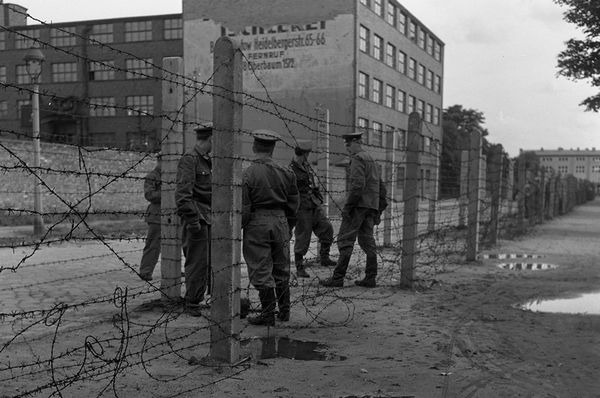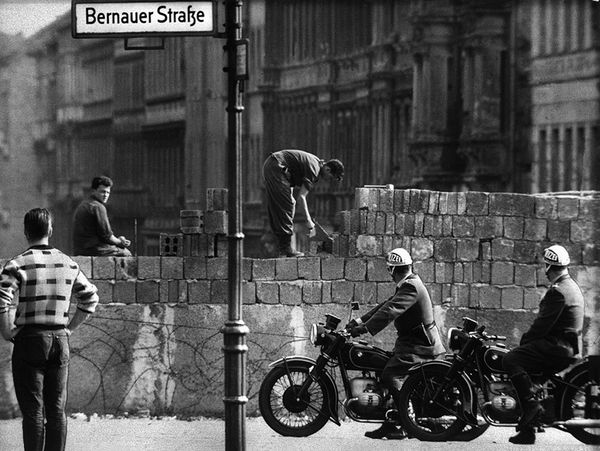The Events of August 1961
The Berlin Wall as it is usually pictured did not appear overnight.
However, just after midnight on Sunday 13th August 1961 the East German army began to close the border with West Berlin.
East German troops and workers began to tear up the streets which ran across the border to make them impassable . They strengthened the barbed wire entanglements that already existed along the 156 kilometres around the three western sectors and added 43 kilometres of new fencing to divided West and East Berlin.






The initial closing of the Berlin border used barbed wire fencing
The first concrete components and large blocks began to be added from the 17th August 1961 and the familiar shape of the Berlin Wall began to appear.
During the construction of the Wall, soldiers stood close by with orders to shoot anyone who attempted to defect.


Great care was taken to ensure that the Wall did not encroach on West Berlin territory......and access to the western side of the wall was possible from the east
In the image above, East German soldiers are guarding both sides of the Wall.
At the same time as the events in Berlin, improved chain fences, walls, minefields and other obstacles began to be installed along the length of East Germany's border with West Germany.

Following the building of the Berlin Wall, Pioneers of the 'Nationalen Volksarmee' add to the IGB defences by installing more parallel fences

The barbed wire of the earlier 1952 border is visible in the foreground with the improved barriers and defences behind - from 1961 onwards millions of mines were laid between the parallel fence lines
In addition to the improved border defences, the DDR authorities began 'Operation Cornflower' (following on from Operation Vermin) to forcibly remove thousands of additional (politically unreliable) villagers from homes that were considered too close to the border.
In every case, it was the same early-morning procedure: a lorry, a knock on the door and two hours to pack.
Their properties were then demolished.......for more examples see "The Border Develops".

Homes and businesses are demolished in the East German town of Asbach
Cross border traffic was reduced to six railway lines and five road crossings.
The harassment of travellers at these points increased and West Berliners/West Germans were often forced to wait for hours before being allowed to continue their journey.

West German cars queue to cross the East German border on the Helmstedt - Berlin motorway
Since the 1950s, the DDR had declared that the Baltic Sea coastline including all the small islands was a restricted-access zone.
From 1961, the last western 15km of the Baltic border was fortified to the same level as the IGB.
The remaining 'Blue Border' was strengthened with numerous watch-towers, more patrols and enhanced travel restrictions.
The millions of East German tourists who came to the Baltic Sea every year had to spend their holidays under special conditions. Strict laws regulated swimming activity, overnight accommodation and the obligatory registration of all kinds of water vehicles.
As well as the police and the Stasi, there was a large number of volunteers who assisted the authorities by looking out for 'suspicious citizens'.

The Baltic border included many isolated areas that were favourite locations for escape attempts
See Extras / Further Reading for more information about one of the most commonly used locations.......Kühlungsborn
A western propaganda video (9:19min) about the building of the Berlin Wall.

